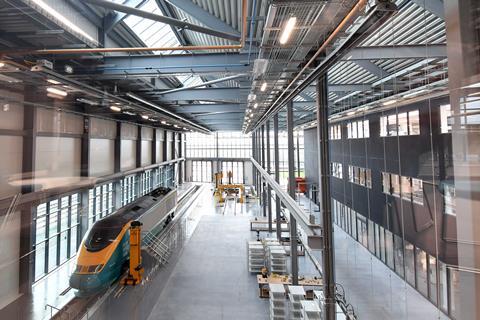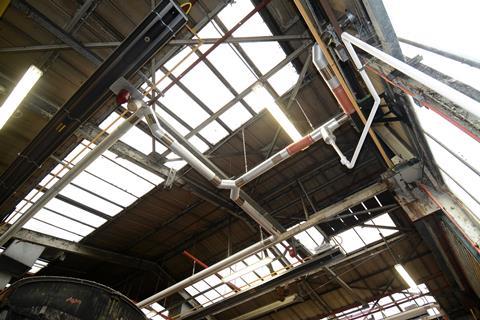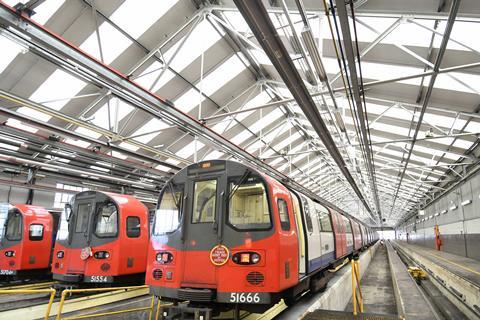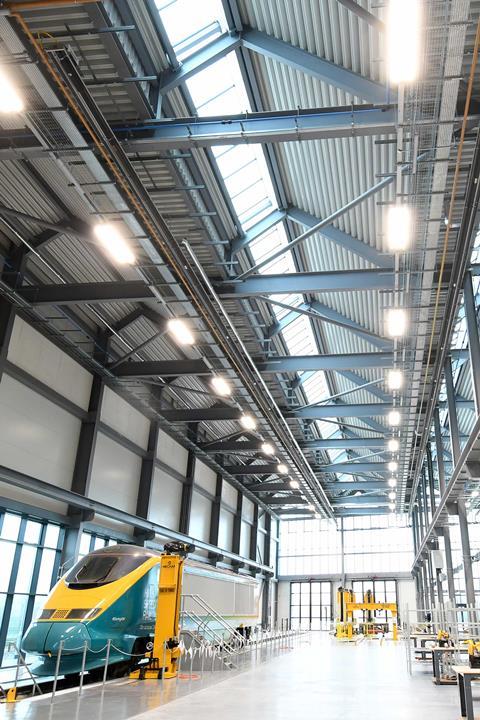This CPD, sponsored by Nortek, will examine how such spaces, often hundreds of metres long and featuring large openings to allow trains to enter, can be maintained at temperatures conducive to those who work in them.
CPD CREDITS: 60 MINUTES
DEADLINE: 10 DECEMBER 2018
For more information about Assemble Media Group’s CPD distance-learning programme, click here


INTRODUCTION
Train depots are used intermittently and at irregular times, making energy efficiency for the buildings difficult to regulate. This CPD will examine how such spaces, often hundreds of metres long and featuring large openings to allow trains to enter, can be maintained at temperatures conducive to those who work in them.
Heating system selection
The ways in which train maintenance sheds are used, often at irregular time intervals, make the efficient use of energy difficult. Therefore, consideration must be given to selecting a heating system that offers flexibility of operation at optimum efficiency.
Train maintenance sheds are invariably very long and narrow with large doors which open regularly and in many cases are left open. As a result such sheds are notoriously difficult to heat and even more difficult to keep warm. The doors often occupy the full width of both ends of the building and may be left open for many hours a day, creating a wind tunnel effect where cold air at high velocity is drawn through the shed. This means that air infiltration can severely disrupt comfort conditions within the building.

A heating system needs to be able to sustain a comfortable environment in these conditions and especially provide rapid recovery once the doors are closed.
Train maintenance is frequently carried out at night, compounding the inhospitable climatic conditions along with partial occupation. It is therefore important for efficient use of energy that the heating system can be easily and effectively zone controlled.
In addition, the mass of a train is considerable; when a cold, wet train enters the shed it creates a cold sink. The heating system needs to be able to provide a rapid response to changed conditions.
Whether ambient or heated, air curtains over or to the side of the depot building’s doors can mitigate the issue of air infiltration at the doors. Industrial air curtains provide a barrier of high velocity air that helps block incoming winds and stops cold air infiltration. They achieve this by delivering a powerful barrier of heated air across the entire width of the doorway.
An open door without the protection of an air curtain not only causes discomfort but greatly increases energy loss and the running costs of the building.

Radiant heating
What is radiant heat? How does it work?
Radiant heat is the transfer of energy by means of electromagnetic waves. When waves strike an object they stimulate molecular activity, causing them to move rapidly and generate heat.
Heat transfer by radiation involves two objects at different temperatures separated by a space transparent to the radiation.
Properties of radiant heat
- Emitted by hot surfaces
- Travels in straight lines
- Passes through the air without heating It
- Absorbed by cooler solid objects on which it falls
Radiant heating can be applied successfully in these challenging buildings. The primary source of radiant energy in the natural environment is the sun. Radiant heat warms all solid objects and surfaces in its path.

Radiant tube heaters, mounted overhead in the roof space, produce infrared radiant heat that is directed downward by a reflector. The infra-red heat passes through the air without heating it and falls on people, floors and equipment below, creating comfortable all-round radiant warmth at low level, without wastefully heating the whole volume of the building or the roof space.
Because radiant heat can be controlled directionally, only the occupied areas of the building need to be heated, which enables considerable energy savings to be realised.
The objective of a radiant heating system is to ensure that people in the building are comfortably warm. By the correct application of a radiant heating system comfort levels can be optimised. Radiant heat warms objects and surfaces, increasing the mean radiant temperature and reducing the body’s loss of heat to its surroundings.
In addition, by eliminating air movement, convective loss of heat from the body will also be reduced.

The importance of zone control
Zone control is a control system in which each zone operates independently in terms of start/stop time. However it is only appropriate where operational conditions change in different zones.
A rail shed may have the capacity to house several trains, meaning controlling individual zones is imperative when considering energy efficiency at the design stage.
Radiant black bulb sensor
Essential for efficient radiant heating systems, black bulb sensors enhance the energy saving capability by measuring the effective radiant temperature within the space being heated.
Assume a scenario of a maintenance shed at half capacity; for example it is only housing two trains and not four. Zone controls assist in maintaining an efficient system by avoiding heating an unoccupied space.

Ways to achieve zone control
- Time Control – This involves setting time parameters in which the design temperatures are required. In addition to time period control, you can further gain credit toward the Effective Seasonal Heat Generator percentage by utilising optimum start and stop. ‘Optimum Stop’ is a control system which stops plant operation at the earliest possible time such that the internal conditions will not deteriorate beyond pre-set limits by the end of the occupancy period. ‘Optimum Start’ is the opposite; it starts plant operation at the latest possible time in order that the internal conditions will up to the required limits at the start of the occupancy period
- Push Button run timer – Very common in rail sheds, this is a simple solution to control the local environment in the operational area of the shed to ensure comfort for the personnel and maximum fuel efficiency for the operator. A press of the button will turn on the appliance for a pre-determined time
- Occupancy sensors – Much like the push button option this will enable the system for a pre-determined period by the means of automatically sensing movement within the zoned space.
The way radiant heat is emitted ensures the most effective heating, ventilation and air conditioning (HVAC) zoning solution for this type of application.

Other HVAC solutions
With long-term maintenance buildings or storage areas, the HVAC design criteria differs to that of a traditional ‘frequently-used’ rail shed. A reduced air change rate will be achieved by the fact that the large loading doors will not be opened as frequently. This offers alternative HVAC solutions which do not need to combat high levels of cold air ingress.
A free blowing warm air design would be suitable for this type of application. A warm air heating system works by passing cool air through a heat exchanger fuelled by gas. The warm air is then blown into the space.
A traditional Air Handling Unit (AHU) can be utilised to provide combined heating, cooling and ventilation to a maintenance workshop. An AHU could be used in conjunction with several distribution ductwork systems;
- Free Blowing: Conditioned supply air proved via a louvre into the space, de-stratification fans to assist with the distribution throughout the area.
- Conventional Ductwork system: A network of metal ductwork to carry the conditioned air to localised diffusers to provide an even temperature throughout the space.
- High Air Induction air distribution system: A lightweight fabric duct that has many small outlet nozzles, either evenly spaced along the length of the duct or located in specific areas. Alternatively, a set of pre-designed nozzles can be used in conjunction with a metal ductwork system.
Air Induction – How it works….
Air is introduced into the duct and forced out of the nozzles/hole at high speed, creating a negative pressure zone - thereby inducing surrounding air and recirculating ‘free heat’ from lighting and heat that has risen to the roof space which would normally be wasted. In sports halls, this can provide significant energy savings (approximately 15%) as traditional de-stratification/air recirculation fans cannot be used because of the air movement created.
The result is a very evenly distributed heat at low air velocities and low noise levels, eliminating excess heat stratification and the need for air re-circulation fans.

Conclusion
The most effective solution provided for a rail maintenance shed is highly dependent on the activities being undertaken within the space. Any solution needs to be reactive and respond to the differing environmental requirements, whether this is to combat high air changes within the space or providing spot heating or zoned control. Once the main requirement is established the correct HVAC solution can then be selected.
Because gas-fired radiant heaters operate under the same conditions at all times, Building Regulations Part L2A (as of 2017) states that “heat generator seasonal efficiency is equivalent to the appliance’s measured steady state thermal efficiency (net calorific value)”. The effective seasonal efficiency is calculated by taking the heat generator seasonal efficiency and adding a number of heating efficiency credits, as determined by the features of the system.
For example, a radiant heating system with optimum start and stop controls and zone controls earns a total of 2.5 heating efficiency credits (0.5% + 1% + 1% = 2.5%). So to calculate the effective heat generator seasonal efficiency, the net thermal efficiency of 91% (in a multi burner system) should be added to the 2.5% heating efficiency credits. The effective heat generator seasonal efficiency is therefore 93.5%, exceeding the minimum standard by 2.5 percentage points. The value that should be entered into the accredited the National Calculation Method for the Energy Performance of Buildings Directive (NCM) tool to calculate the carbon dioxide emission rate is 93.5%.
NCM is the procedure for demonstrating compliance with Building Regulations (for buildings other than dwellings) by calculating the annual energy use for a proposed building and comparing it with the energy use of a comparable ‘notional’ building. Both calculations make use of standard sets of data for different activity areas and call on common databases of construction and service elements.
The NCM allows the actual calculation to be carried out either by approved simulation software or by a simplified tool based upon a set of CEN standards. Another of these tools is the Simplified Building Energy Model.

How to take this module
Assemble Media Group’s CPD distance-learning programme is open to anyone seeking to develop their knowledge and skills. Each module also offers members of professional institutions an opportunity to earn between 30 and 90 minutes of credits towards their annual CPD requirement.
This article is accredited by the CPD Certification Service. To earn CPD credits, read the article and then click the link below to complete your details and answer the questions. You will receive your results instantly, and if all the questions are correctly answered, you will be able to download your CPD certificate straight away.
CPD CREDITS: 60 MINUTES
DEADLINE: 10 DECEMBER 2018
Privacy policy
Information you supply to Assemble Media Group Limited may be used for publication and also to provide you with information about our products or services in the form of direct marketing by email, telephone, fax or post. Information may also be made available to third parties. Assemble Media Group Limited may send updates about Building CPD and other relevant Assemble Media Group Limited products and services. By providing your email address you consent to being contact by email, telephone, fax or post by Assemble Media Group Limited or other third parties. If at any time you no longer wish to receive anything from Assemble Media Group Limited or to have your data made available to third parties, contact the Data Protection Coordinator at building@building.co.uk. View our full privacy policy he

















No comments yet